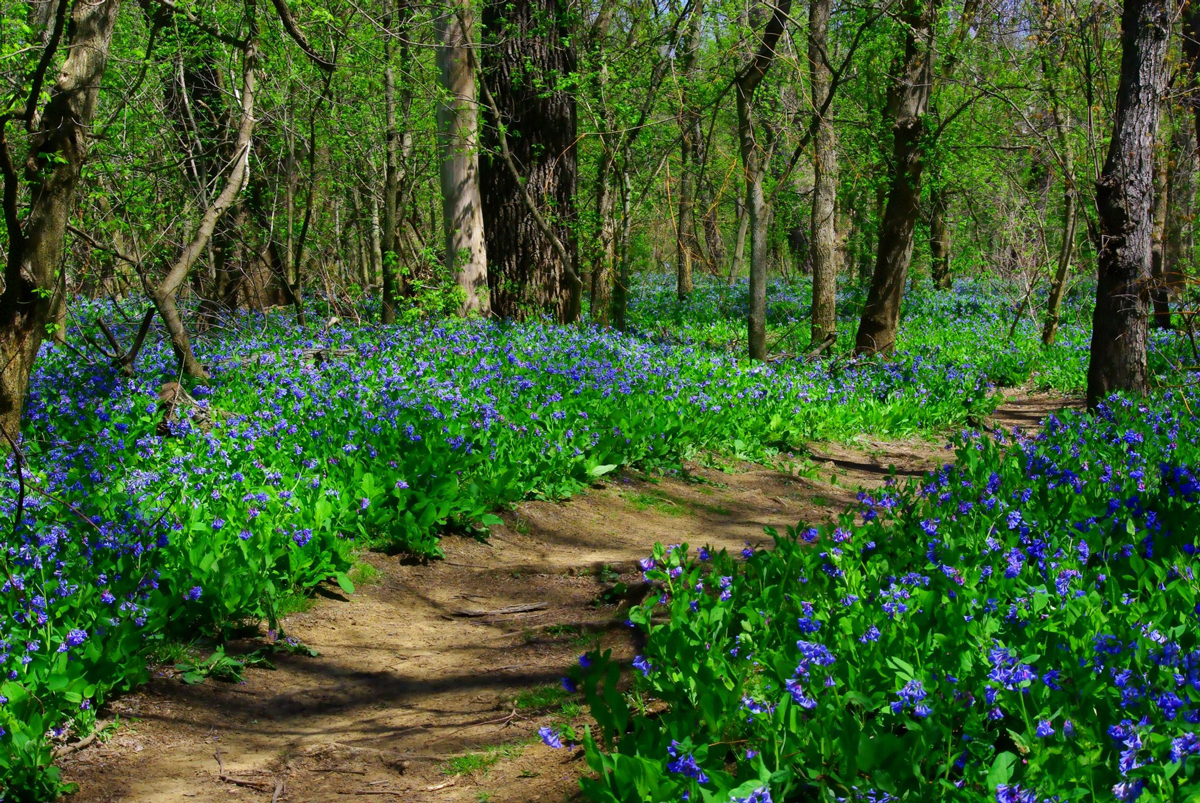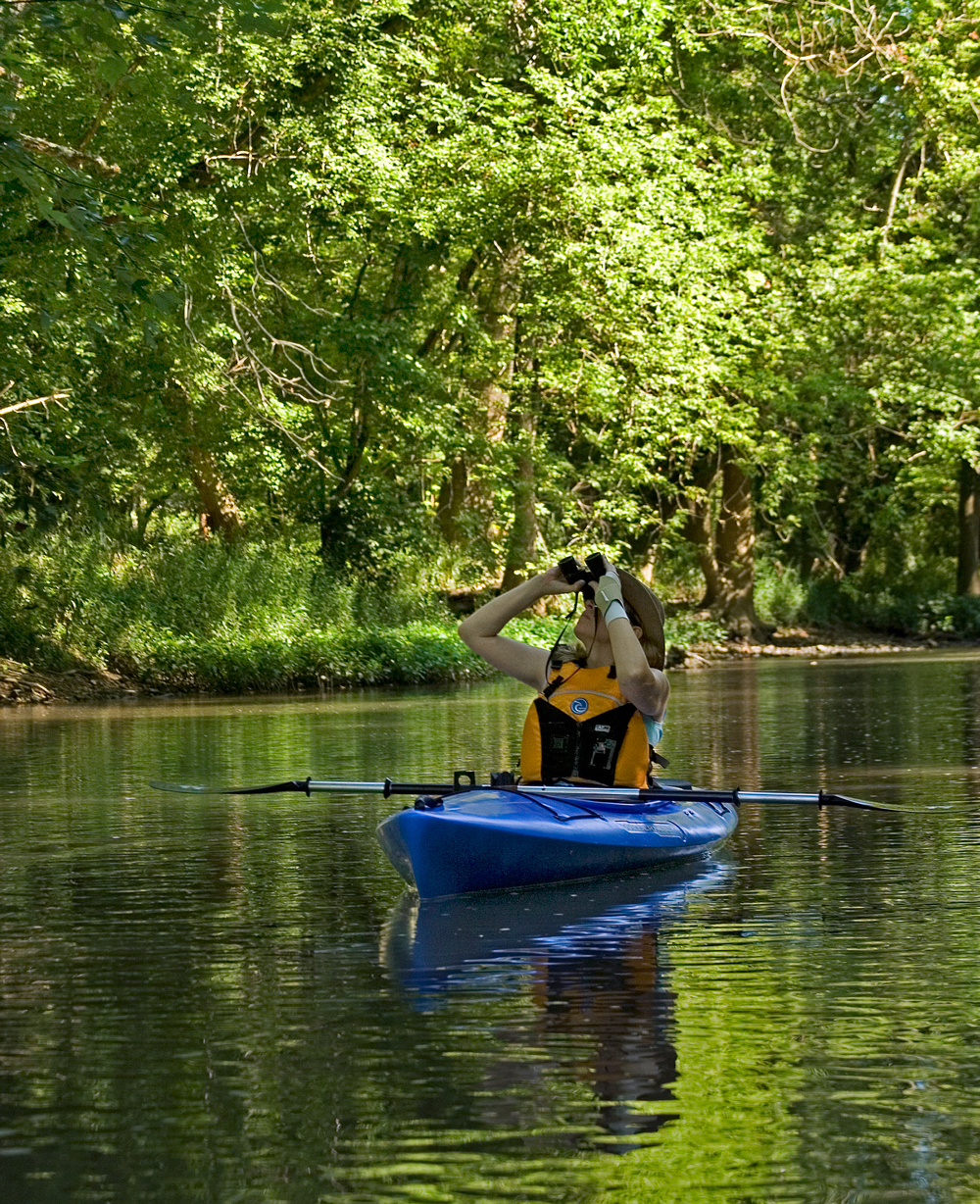VIRGINIA GORDON
Communications Coordinator
Following the launch of our 20 IN 22 theme in the January edition of Metro Parks News (20 IN 22: A Multigenerational Celebration of Metro Parks), we now present the first of ten monthly articles, each one focusing a narrower attention on two of the 20 outstanding parks that comprise the Columbus and Franklin County Metropolitan Park District. Today we look at the 11th and 12th parks in the Park District (Three Creeks Park and Prairie Oaks Metro Park), which opened within four years either side of the millennium.

–
THREE RIVERS BECOMES THREE CREEKS
Three Creeks became the 11th Columbus & Franklin County Metro Park in 1998, but a 410-acre park called Three Rivers Park had existed on site since the early 1970s. The City of Columbus Recreation and Parks Department operated Three Rivers Park on land that encompassed the confluence, or coming together, of the three rivers (creeks, actually), Alum Creek, Blacklick Creek and Big Walnut Creek.
In June 1998, the City of Columbus leased its then 500-acre site to Metro Parks for management and development of what became known as the Three Creeks Park Project. Renamed from Three Rivers Park to Three Creeks Park (note, the official name does not include the word ‘Metro’ although it is often referenced as Three Creeks Metro Park), Metro Parks acquired new land through purchases and easements, for what is now a 1,100-acre park and one of the major hubs in the Central Ohio Greenways system. Both Metro Parks and the City of Columbus are major partners in the Greenways project, developed by MORPC (the Mid-Ohio Regional Planning Commission) to add Greenway Trails that connect our region’s scenic river corridors with local neighborhoods, parks and attractions.

–
A MEETING POINT FOR TWO GREENWAY TRAILS
Metro Parks opened the first 7.5-mile section of the Alum Creek Greenway Trail in 1999, and the first 2.8-mile section of the Blacklick Creek Greenway Trail in 2001. Both trails have their start points in the Confluence Trails Area, one of five distinct areas of Three Creeks Park. The Blacklick Creek Greenway Trail has now been extended beyond the park, connecting Three Creeks Park with both Pickerington Ponds and Blacklick Woods Metro Parks, over a length of 16 miles. Meanwhile, the Alum Creek Trail now extends north of Three Creeks Park and terminates at Polaris over a distance of nearly 25 miles. These wide, paved trails are very popular with bikers and they also have plenty of room for hikers, with or without leashed pets.
The construction of I-270, which intersects the park, had required the creation of borrow pits, taking soil to help in the construction of overpasses and highway interchanges. Some of these pits became ponds, the largest being what became the 10-acre Heron Pond, now an area of scenic beauty and also a great spot for fishing. Park guests can fish for bluegill, catfish and largemouth bass. Fishing is also available at nearby Turtle Pond and in any of the three creeks.
BEAUTIFUL NATURE TRAILS YIELD VIEWS OF THE CONFLUENCE

–
The confluence of the creeks can be viewed by guests who walk either the Confluence or Bluebell Trails. These beautiful nature trails are for hikers only, but the Evergreen Trail is also a natural surface and allows leashed pets. The Evergreen Trail loops around a 12-acre natural play area, where young and old can climb trees, play off-trail or dig in the dirt of a pine forest. Many of the pine trees were planted there by the city in 1981, when Columbus was designated as a Tree City USA, a program sponsored by the National Arbor Day Foundation.
In addition to Metro Parks Park Rangers, Naturalists, and Maintenance Technician Team Members, guests are likely to encounter City of Columbus staff also, as the city still has a presence at Three Creeks Park. It manages the Sycamore Fields Area, which has fenced-in dog parks for both large and small dogs, plus four baseball/softball diamonds and seven playing fields for soccer and football. The Smith Farms Area is also maintained by the city’s Recreation and Parks Department. For many years, the city hosted a Fall Harvest Jamboree on site in October, to celebrate the history of Smith’s Famous Farm, a once-thriving vegetable farm.
*
PRAIRIE OAKS BECOMES THE FIRST METRO PARK OF THE 21st CENTURY

Prairie Oaks, the 12th Metro Park, would become the second park through which Big Darby Creek flowed. Although the official opening of the park would be delayed until 2002, the park district began acquiring land for the future Prairie Oaks Metro Park in 1991. In 2000, a Park Manager was appointed for the future park, and both she, (the first female Park Manager in Metro Parks) and the Park Naturalist at Battelle Darby Creek Metro Park, would lead hikes in Prairie Oaks, along the newly-created Sycamore Plains Trail.
At that time, the new park extended to just under 1,300 acres. Much of this land had been acquired by the City of Columbus in the 1970s, when the city intended to submerge the area and create a reservoir for Columbus’s and Franklin County’s future drinking water needs. This Upper Darby Dam project attracted widespread opposition from environmental groups and the plan wasn’t fully dropped until 1992.
Ironically, merely the proposal of the Upper Dam Project, and another ultimately rejected flood-control reservoir project, the Lower Dam Project proposed by the US Army Corps of Engineers, had spared the Darby Creek watershed from the attentions of housing and strip mall developers. Their eyes would have been on the area, after the I-70 and I-270 construction in the 60s and 70s created a population swell. But no one builds a strip mall on land that might be 50-feet underwater in times-to-come.
Today, thanks to this combination of good fortune and good management, Prairie Oaks Metro Park has grown steadily and now stands at 2,203 acres. More than two miles of Big Darby Creek flows through the park, which also features some outstanding natural areas that predate European settlement. This includes a 30-acre oak-savanna, a mixture of oak woods and grasses that provides a perfect habitat for grassland bird species. To honor the pre-settlement history of the Darby Plains, once a vast wet-prairie ecosystem, Metro Parks has restored 800 acres of prairie at the park, using native seeds hand-collected from tiny remnant prairies. The prairies are a must-see for park guests in July and August, when the spectacular blooms of various coneflower and sunflower species produce a riot of color in amongst the tall prairie grasses.
–
DARBY BEND LAKES

–
The Darby Bend Lakes area opened in May 2006. It features three large ex-quarry lakes, ideal for various water activities, such as fishing, canoeing and kayaking and non-motorized boating. One of the lakes has its own dog beach where your furry friends can swim with joy. The Darby Bend Lakes area is the center point for the annual Wag! Fest, a festival that brings thousands of four-legged guests and their two-legged handlers to the park every August.
Beaver Lake, another ex-quarry lake, is the heart of a 25-acre natural play area. Located in the northernmost part of the park, it is surrounded by the 0.9-mile Beaver Lake Trail, one of 10 trails in Prairie Oaks, totaling more than 17 miles, and including a 5.7-mile Bridle Trail.
Prairie Oaks was the first Metro Park to operate a carry-in, carry-out trash program, providing bags for guests to take away their trash. The success of this program has seen it extended to Walnut Woods, Rocky Fork and Scioto Grove Metro Parks, which all opened in the 2010s.
*
As our 20 IN 22 series continues, next month we’ll take a look at Highbanks and Walnut Woods Metro Parks. Stay tuned and see you at Metro Parks!

Does your Little Turtle-Big Walnut Creek park have a name. And will there be marked trails with blazes and a map of the park? I’m afraid I would get lost in this heavily wooded park.
Hello Tom – I promise you, you won’t get lost. There are brown marker posts to give guests an idea of where to explore. This area of Blendon Woods is called ‘100 Acre Wood’ and it’s a magical area, with pristine forest and streams. You can access this wonderful area from 5220 Cambria Way, Westerville, Ohio. There are some established trails in the area, but you can you make your own way and discover land as it used to be before European settlement of Ohio. The entire area allows leashed pets. There are no current plans for a map of the area, but you can check out this Tim Talks video about our 100 Acre Wood here: https://www.metroparks.net/blog/tim-talks-discover-metro-parks-100-aker-wood/